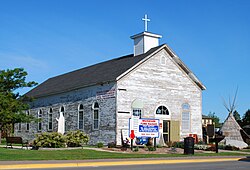St. Ignace Mission
|
St. Ignace Mission
|
|

Mission in 2009
|
|
| Location | State and Marquette Sts., Marquette Park, St. Ignace, Michigan |
|---|---|
| Coordinates | 45°52′18″N 84°43′55″W / 45.87167°N 84.73194°WCoordinates: 45°52′18″N 84°43′55″W / 45.87167°N 84.73194°W |
| Built | 1837 |
| NRHP Reference # | 66000398 |
| Significant dates | |
| Added to NRHP | October 15, 1966 |
| Designated NHL | October 9, 1960 |
| Designated MSHS | August 23, 1956 |
The St. Ignace Mission is located in a municipal park known as Marquette Mission Park. It was the site of a mission established by Père Jacques Marquette, and the site of his grave in 1677. A second mission was established at a different site in 1837, and the chapel was moved here in 1954. The second mission chapel is the oldest Catholic church in Michigan and Wisconsin. The St. Ignace Mission was designated a Michigan State Historic Site in 1956, and was declared a U.S. National Historic Landmarks in 1960, one of the earliest sites recognized. The mission chapel serves as the Museum of Ojibwa Culture.
In 1670, Claude Dablon established a Catholic mission on what became known as Mackinac Island. That mission was presumably destroyed, as Père Jacques Marquette established a French Jesuit mission at the same location in 1671.
However, in the fall of the same year, Marquette moved the mission to a location on the north shore of the Straits of Mackinac at the site of the present mission chapel. Marquette built a small log cabin at this site to serve as a chapel, and ministered to the Native Americans in the area, in particular the Petun. This people had recently settled in the area after clashes with the Iroquois, as well as the French inhabitants of the Straits.
In 1674, Marquette joined Louis Jolliet on an exploration journey to trace the route of the Mississippi River. The party overwintered on the shore of Lake Michigan in what is now Chicago; however, Marquette's health had suffered on the trip, and he died in 1675 while returning to his St. Ignace mission. Marquette had expressed a desire to be buried at the mission. In 1677, his followers exhumed his remains and carried them for reinterment at St. Ignace. There, they were placed in a birch box and buried beneath the chapel.
After Marquette's death, the mission was taken over by Father Phillip Pierson, and then Father Nouvel. A new chapel was built in approximately 1674, and by 1683 the mission was so successful and prosperous that three priests, Fathers Nicholas Potier, Enjalran, and Pierre Bailloquet, were assigned there. However, the establishment of a French garrison at St. Ignace in 1679 wound up souring relations between the French and the local population. When Antoine Laumet de La Mothe, sieur de Cadillac left the area to found Detroit in 1701, bringing many of the St. Ignace residents with him, the importance of the mission declined dramatically.
...
Wikipedia
